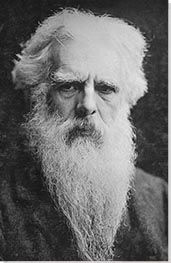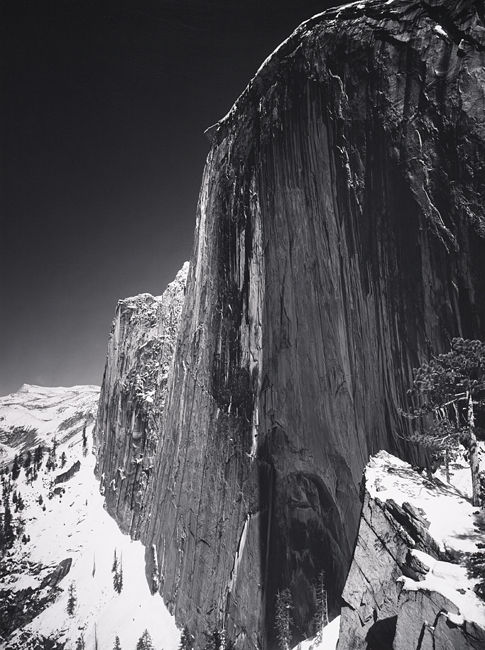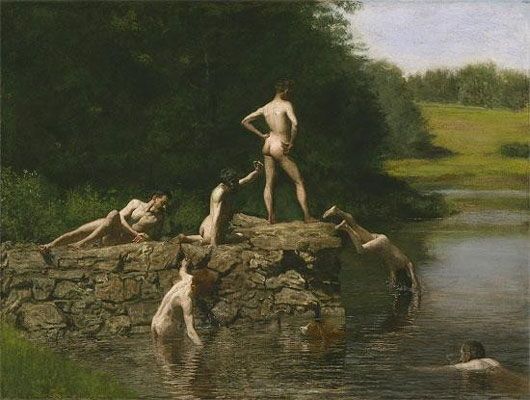Summary of Eadweard Muybridge
Eadweard Muybridge pioneered photographic techniques that allowed new forms of documentation of modern life. Muybridge combined refined aesthetic sensibilities, technological innovation, showmanship, and commercial wiles to position himself as the preeminent photographer of San Francisco's capitalist elite. His photographs of the Californian landscapes experiment with perspective and painterly effects, while his work for various government bureaux offers early examples of the ways in which photography could serve a propaganda role. Muybridge's most pioneering work was in the study of motion, capturing horses, humans and other animals carrying out a range of actions; his reduced exposure times allowed for sequences to be frozen into sets of images, resulting in a greater understanding of anatomy. Toward the end of his life, Muybridge began to experiment with setting these sequences in motion, which paved the way for subsequent development of the motion picture.
Accomplishments
- Eadweard Muybridge played a significant role in the development of instantaneous photography, working with both chemicals and shutters to produce shorter exposure times. These meant that he was able to isolate particular moments, famously capturing the stages of motion, showing the audiences the positions through which animal and human bodies shifted while performing actions, which lead to advances in areas as diverse as zoology, painting, and motion pictures.
- Muybridge's work created a bridge between Europe and the United States. While Paris and London were centres for photographic innovation, new forms of capitalism were emerging as the United States expanded westward. Muybridge drew upon contemporary European technological and artistic trends in order to document the changes taking place in late-19th-century California, constructing a modern identity for the West Coast of America.
- Muybridge's attention to presentation had an impact long after his death, paving the way for post-war Conceptual artists to experiment with photography's apparent veracity. Muybridge used precise measurements, grid arrangements, and sequencing to construct an image of objectivity that continues to be persuasive. His photographs presented the motions of life in ways that transformed the everyday into the spectacular.
Important Art by Eadweard Muybridge
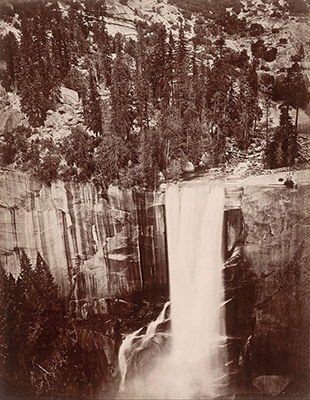
Pi-Wi-Ak (Shower of Stars), Vernal Falls, 400ft, Valley of Yosemite
This photograph shows a waterfall from above, positioned so that the water cascading down the cliff is in the lower half of the frame, slightly right of centre, while the upper portion of the frame shows trees and rocks. The image is cropped such that the sky is not visible and the position from which the photograph has been taken is unclear, creating a sense of instability in the viewer. The vertical lines of the limestone and the trees above, along with the portrait orientation of the photograph, reinforce the waterfall's downward pull. The waterfall is exposed such that it dissolves into a white blur, misting on the rocks at the lower edge of the image.
This was one of many photographs that Muybridge took around Yosemite, which had become an iconic part of Californian identity by 1860. Muybridge takes a romantic approach to the landscape, emphasising Yosemite's dizzying scale and creating a sense of contrast between the solid rock, evenly exposed, and the uncontrolled motion of the waterfall. He chose a subject that had been heavily represented in nineteenth century European art, registering as sublime and mythic, evoking a sense of awe. Muybridge's approach, like that of many other 19th-century photographers, valued aesthetics over honesty; he was known for cutting down trees which blocked the views he wanted and adding rocks and clouds in the darkroom. Muybridge was best known, however, for the heights to which he would climb, carrying heavy equipment, and for the dangerous positions in which he would place himself in order to secure shots such as this, inspiring awe among his audience.
Albumen print

Panorama of Lava Beds from Signal Station at Tule Lake, Camp South
This panorama, commissioned by the United States Army to document the Modoc War, show an encampment on the banks of Tule Lake. Muybridge has taken the three images that comprise the panorama from a signal station above the army camp; the many tents and figures shown are small against the vast landscape, which occupies the bulk of the frame. The horizon line is close to the upper limit of the picture plain and the lake stretches beside and behind the encampment, creating a sense of the vastness of inland California and Oregon.
At this point, the Modoc War dominated the news, but it was also almost over. In 1872, violence broke out after the US Army arrested the Native American Kinstspuash, who led the Modoc resistance against forced resettlement. Muybridge's photographs were intended to capture the territory on which the battles had been fought both for reporting and for future reference. The Modocs had fled by the time Muybridge arrived, meaning that the photographer fictionalised many images in order to convey an impression that battles were ongoing outside the encampment, labelling military scouts as Modocs and shooting images in which soldiers posed in ways that implied ongoing warfare. Muybridge's choice to photograph this panorama from above, with the camp in the foreground and the flat landscape receding into the distance, shorn of detail by the distance from which the image is taken, creates an impression of the landscape as barren, heightening the viewer's sense of the army as pioneers, rather than invaders. The panorama, like the group of which it forms a part, is an early example of photography's role in shaping public opinion and of Muybridge's own ability to subtly construct images that position themselves as documentation so as to conceal their propaganda purposes.
Albumen prints
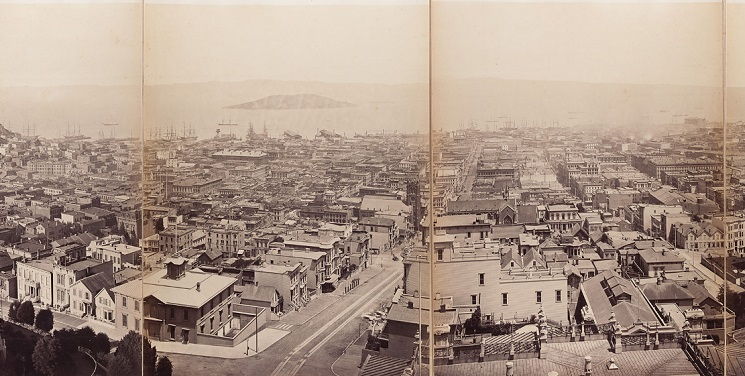
Panorama of San Francisco
This panorama of San Francisco consists of thirteen prints, each measuring eighteen by twenty-two inches. These images afford the audience a view of the growing city in 360 degrees, with Powell Street, Pine Street and California Street guiding the eye from the foreground toward the background, where Yerba Buena Island, Angel Island and Alcatraz appear at various points on the horizon, along with houses in various directions, growing smaller. The mammoth plates used by Muybridge afford an unprecedented level of detail in each print, with architectural details, vehicles and ships in the harbour's haze all rendered legibly.
Muybridge's panorama offers a document of San Francisco's cityscape which operates as a testament to the capitalist class with whom the photographer aligned himself. Muybridge surveys the city from Nob Hill, home to San Francisco's business leaders, emphasising their centrality through the positioning of their properties in the foreground and creating a sense of power and ownership over the surveyed. The hotels, public and commercial buildings and private houses all operate as objects of civic pride and as testament to the city's growth; the ships in the harbour and the presence of vehicles in the streets of the panorama emphasise San Francisco's place as a commercial hub. It is impossible for the viewer to take in the entirety of the panorama at once; instead, the set of photographs demand physical movement, involving audiences in the drama of the image. This impresses Muybridge's technical mastery on the viewer; while mammoth plates had previously been used for panoramic cityscapes, including in San Francisco, Muybridge was ambitious in his decision to show the city in 360 degrees. The scale of this group of photographs allowed San Francisco to be captured and displayed in a way that defies the limitations of human sight.
Albumen prints
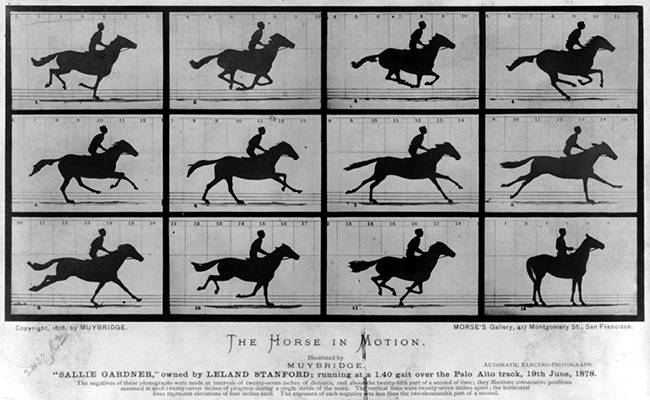
Sallie Gardner at a Gallop
This print, also known as The Horse in Motion, is amongst the earliest of the studies for which Muybridge would become known. Each of these twelve images show a horse, with rider, paused at a different moment in her paces. The horse and rider, rendered as silhouettes due to the lighting conditions and exposure time, are shown at the centre of each frame against a lined and numbered backdrop; the frames are arranged in a grid. The first frame shows the horse with one leg touching the ground, about to leap up, as seen in the next two frames, into a gallop, before moving through a longer stride in preparation for the next leap. In the twelfth frame, the horse and rider are shown at a standstill.
This set of images are best-known as a demonstration of the method Muybridge used to prove Leland Stanford's theory, on which he had a bet, that a horse leaves the ground completely while galloping. These images allowed people to understand the mechanics of the horse's motion, which had previously registered only as a blur, and so had implications for both scientists seeking to understand anatomy and artists attempting to represent it. Muybridge had, in order to capture these frames, developed new chemicals and new shutters for his camera; Stanford's financial and technical support made it possible, also, to design a track specifically in order to capture the horse, with twelve cameras that could be triggered rapidly by the horse itself through wires extending across the track, which was, like the backdrop, covered with powdered white lime to reflect as much light as possible. These images generated immediate discussion, much of which revolved around whether Muybridge's innovations belonged to the realm of art or that of science.
Albumen print
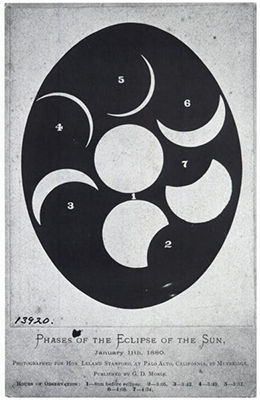
Phases of the Eclipse of the Sun
This image records the total solar eclipse of January 11, 1880, collapsing the eight stages of the eclipse into one sequence of exposures. These stages are clearly numbered and progress in a clockwise spiral within a larger dark oval. In the first image, at the centre, before the eclipse begins, the sun is a round, bright disk. The second, directly below this, shows the disk with a segment in the lower right obscured by the moon, which continues to obscure more of the sun in each exposure, culminating with the fifth exposure, at the upper centre of the Muybridge's image, in which the sun appears only as a thin crescent; Muybridge did not secure a shot of the full eclipse. In images six and seven, the moon recedes as the earth's rotation continues to create the impression that the eclipsing sun is itself rotating around the image. The images, arranged together, numbered and retouched before being reproduced through photography in Muybridge's studio, are neat enough as to appear more as a drawn diagram than a series of photographic exposures.
Muybridge gave this image to Leland Stanford as a parting gift when he left Palo Alto in 1881. It speaks to their shared interest in photography as a scientific tool, capturing the stages of the eclipse, but can also be read as speaking to their relationship and ambition; Muybridge's professional identification with Helios, the sun-god, contributes to a reading of the pair's partnership as akin to that of the sun and the moon, working with and against one another to create this rare solar phenomenon. The way in which the eye is encouraged to travel in a circular fashion also hints at the direction in which Muybridge's work would subsequently move, imitating the way in which the photographer and inventor's 'praxinoscope' would later set still images in motion through a rotating device.
Composite albumen print
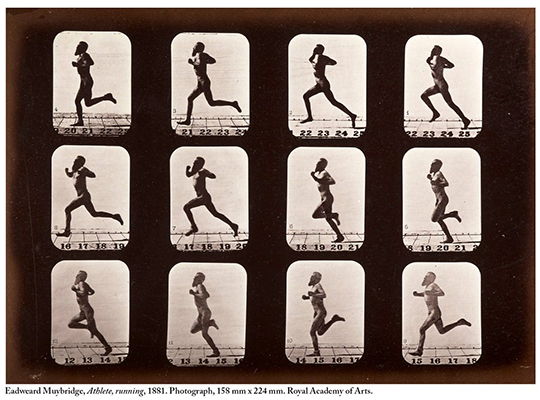
Man Running
This group of twelve frames continue Muybridge's motion studies into an investigation of the human body. The images are similar to his earlier shots of a horse running; the man in these frames appears in the centre of each, against a white background, with a measuring system at the base of his body. This man is of athletic build, bearded and nude. The twelve frames read from right to left, with the figure running in the direction in which his body is facing, disrupting the western viewer's usual habit of reading sequences from left to right; the initial confusion caused by this serves to involve the audience more closely with the frames. Each of these images has rounded corners and is set within a black border similar to those used by Muybridge elsewhere, reinforcing the relationship of Man Running to his larger body of work investigating motion.
The man in this group of images is, in fact, Muybridge himself, a fact that likely stems from his own availability as a model to whom the process would not need to be explained and with whom the repetitive nature of the work would not as easily grate. This means, however, that the sequence also operates as a self-portrait and serves as a reminder of the degree to which Muybridge was not a disinterested technician but deeply involved with the construction of an aesthetic as concerned with the appearance of scientific objectivity as its actual presence. Muybridge's motion studies are consistently arranged to form visually compelling narratives; the Grecian appearance of the male bodies, including his own, used in images such as Man Running heighten the dramatic effect of these sequences, as does the stage-like setting and framing. Muybridge, known for his showmanship and sense of the spectacular, presented these images in public lectures, where critics keenly noted that he did not trust the images to speak for themselves.
Albumen print
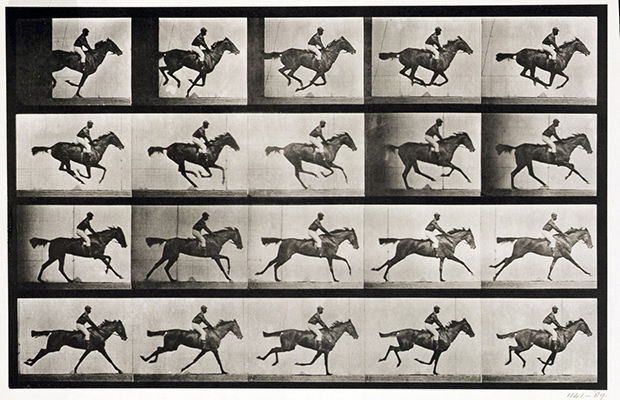
Jockey on a Galloping Horse from Animal Locomotion
Jockey on a Galloping Horse shows the evolution of Muybridge's most famous subject, the horse in motion, with which he was increasingly able to capture detail. This sequence consists of twenty exposures of a jockey atop a galloping horse, arranged tightly together with only a minimal black border; the backdrop is plain and the horse and jockey are centred in each frame, moving from left to right. In this set of images, Muybridge has succeeded in capturing a greater level of detail than in previous studies, with the muscles of the horse, the shine of its coat, the whip of its mane and the folds of the jockey's clothes all visible.
By this point, Muybridge had begun experimenting with animating his photographic sequences through an invention he labelled the 'praxinoscope.' This worked similarly to a zoetrope, with a spinning mechanism and mirrors used to create bright, continuous images. Muybridge showed many of his images, including Jockey on a Galloping Horse, with the praxinoscope at the World's Columbian Exposition in Chicago in 1893. His presentation of real, everyday subjects - such as a horse running - as aesthetic and technological marvels played into the period's increased emphasis on spectacle. In animating this sequence, such that the horse appears to run before the audience, Muybridge positioned himself as able to stop and start time through the mechanisms of the camera. In reanimating a horse within an exhibition space, from a set of still images, the photographer used technology to gain mastery over nature and opened up possibilities for further experimentation with the moving image, laying groundwork for motion pictures and photographic performance art.
Collotype
Biography of Eadweard Muybridge
Childhood
Eadweard Muybridge, then Edward James Muggeridge, was born in Kingston-upon-Thames, a market town southwest of London, in 1830. England changed rapidly during his youth, as the Industrial Revolution widened the gap between the wealthy and those living in poverty as new technologies were developed and traditional agriculture waned. Muybridge's father worked as a coal and grain merchant and this position, coupled with the position of Kingston-upon-Thames as a trade centre, meant the family were secure despite the changes. Muybridge and his two younger brothers were exposed to the delights of the modern age without the dangers. Muybridge was reportedly adventurous as a child, with a desire to explore the world from an early age. Muybridge's father died in 1843 and his mother took over running the family business, which operated successfully into the 1850s.
Early Training
Muybridge, whose name's spelling transformed a number of times throughout his youth, initially left Kingston-upon-Thames for London, where he worked as a sales agent for the London Printing and Publishing Company. This job allowed him to make his way to New York and San Francisco, where he arrived between 1852 and 1855. California was, at the time that Muybridge arrived, a relatively new state in the midst of a gold rush and Muybridge positioned himself to cater to the growing mercantile class, opening a bookstore and an office for the London Printing and Publishing Company. Muybridge's building was next door to the daguerreotype studio of R.H. Vance, one of the most important photographers documenting the gold rush, and was shared with William Shew, a portrait photographer. While the specifics of his introduction to and training in photography are unknown, Muybridge soon began to sell others’ photographs, alongside books and engravings.
Muybridge's two younger brothers arrived late in the 1850s to work alongside him as booksellers in California and he took advantage of this to make plans to return to Europe in 1860 for work, travelling via St Louis and New York. His stagecoach, however, hit a tree in Texas, leaving Muybridge with a severe head injury. He went to Arkansas, New York and then London for treatment.
While in England, Muybridge filed a lawsuit and won a settlement from the Butterfield Overland Mail Company in 1861 and applied for patents for two inventions, one of which was a metal plate-printing device and the other of which was a kind of washing machine for textiles, exhibiting these in London at the International Exhibition of 1862. It is almost certain that Muybridge would have seen the significant display of photography held at the exhibition, with an emphasis on technologies that could shorten exposure times, and followed the event's central debate over whether photography was an art or a science. There is little information available on Muybridge's activities in these years, though he had become financially involved with mining in Nevada and banking in Turkey by 1865 and must have worked to develop his understanding of photography while in the United Kingdom. His speculative ventures collapsed in the Panic of 1866 and Muybridge returned to San Francisco after this, beginning his career in photography under the name HELIOS Flying Studio. Muybridge's background gave him an excellent ability to promote his own work and he quickly established himself as a "view artist," marketing himself to art galleries, collectors, government bodies, railroad companies and newspapers.
Mature Period
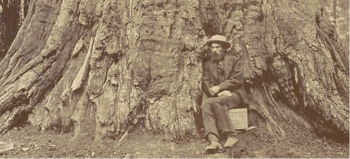
By 1868, Muybridge had established himself as a photographer specialising in Californian landscapes, positioning himself as a competitor to Carleton Watkins, who had pioneered photography in Yosemite Valley. In 1871, Muybridge married Flora Stone, having assisted her in securing a divorce from another husband earlier in the year. Stone had worked with Muybridge as a retoucher and was supportive of Muybridge's photography and frequent absences for work that involved travelling, though Muybridge quickly became suspicious of his wife developing independent interests and spending time with others.
It was around this point in time that Muybridge began his most significant professional relationship, with the industrialist Leland Stanford. In 1872, he visited Stanford's ranch in Palo Alto to take his first photographs of a horse in motion, intended to settle a bet Stanford had as to whether all four of a horse's hooves left the ground simultaneously while galloping. These experiments, in which Muybridge attempted to increase exposure speeds in order to create an image of paused motion, would continue over the remainder of Muybridge's life.
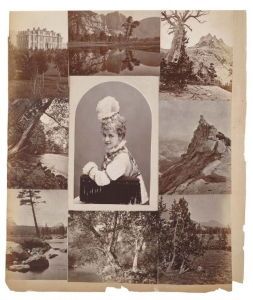
In 1874, Flora Muybridge gave birth to a son, Florado Helios Muybridge. Muybridge's mother died only a few days after this, disturbing Muybridge emotionally and complicating his feelings about the birth. Muybridge reportedly discovered a photograph of his child bearing the inscription 'Little Harry!' leading him to believe that the child had been fathered by another man, Harry Larkyns, with whom his wife was acquainted.
In October, Muybridge made his way to Yellow Jacket Mine, where Larkyns lived, arriving at night and asking to see him, introducing himself with the phrase "My name is Muybridge and I have a message from my wife." In the most widely circulated version of these events, Muybridge then produced a revolver and shot Larkyns, killing him. It is difficult to know the degree to which Muybridge's motivations or actions were embellished by the press, which covered the murder in great detail, but there was and is consensus that Muybridge committed the act.
Muybridge was jailed for four months awaiting his trial for murder, in which he was acquitted by a jury of elderly men who sympathised with Muybridge's reasons for killing Larkyns, particularly as his lawyer, William Pendegast, argued that in losing his "home, wife, child, content and peace" Muybridge had lost enough. Muybridge's renown as a photographer played a significant role in securing his freedom, as Pendegast argued that his genius was such that he must be able to continue to work.
Flora Muybridge divorced her husband soon after the trial and died almost immediately after this, leaving Floredo Muybridge to grow up in orphanages. Muybridge's belief that the child was not his has been questioned, with Floredo Muybridge coming to bear a close resemblance to Eadweard Muybridge later in life. Muybridge returned to photography several months later, travelling to Central America on a commission by the Pacific Mail Steamship Company that had been delayed due to his trial.
The scandal did not dampen Muybridge's career. Back in California, in 1877, he was invited to return to Leland Stanford's ranch, where he began to create quick-exposure studies of animals and people in motion, famously capturing the gait of Stanford's racehorses. By 1881, Muybridge had invented the zoopraxiscope, which allowed him to reverse the process he had refined, setting still images in motion.
Late Period and Death
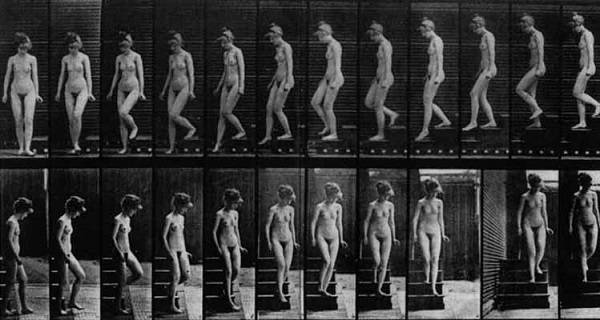
In 1883, Muybridge moved to the East Coast to take up a position at the University of Pennsylvania, allowing him to continue his studies of the human body in motion, capturing actions including, running, somersaulting and pouring water. He gave lectures and demonstrations across Europe and the United States, but found his success marred by the publication of The Horse in Motion by J.D.B. Stillman and Leland Stanford, in which the pair downplayed Muybridge's contributions to the earlier motion studies, suggesting that he was hired simply to execute the ideas of others. Muybridge took Stanford to court for damages over this, spending three years arguing a case that he ultimately lost. Nonetheless, Stanford and Muybridge appear to have partially reconciled by 1892, when the photographer again visited Palo Alto.
In 1894, Muybridge returned to Kingston-upon-Thames, where he spent the last decade of his life gardening. Muybridge was not active as a photographer in this period, though he continued to lecture and published two books, Animals in Motion and The Human Figure in Motion, featuring his earlier work. Suffering from prostate cancer, the photographer spent much of his time setting his affairs in order by disposing of unwanted papers and arranging for his photographic work to be left to the Kingston Museum and donating copies of his books to the University of California in an apparent attempt to reassert the importance of his centrality, as opposed to that of Leland Stanford, in documenting the horse in motion. The photographer died in 1904, at the Kingston-upon-Thames home of his cousin, Catherine Edith Smith. The slab marking the burial of his ashes at Woking Crematorium granted one last change of name, accidentally engraved with "Maybridge."
The Legacy of Eadweard Muybridge
Eadweard Muybridge had a substantial impact on artists working across a range of media and a variety of subjects. His images of Yosemite influenced later work in the same region by Ansel Adams and his use of unconventional perspectives can be seen in the more recent work of Andreas Gursky and Mark Klett; the influence of Muybridge's application of photography toward documentary and propaganda purposes is clear in work by Lewis Hine and Dorothea Lange. Muybridge's work as a technological innovator played a significant role in the subsequent development of moving images by William Dickson and Thomas Edison.
Muybridge's most pronounced impact was on painters taking animals as subject matter; his studies of horses in motion provided insights that shaped the ways in which Edgar Degas and Jean-Louis-Ernest Meissonier represented these animals. His studies of bodies, animal and human, provided a substantial body of data that informed understanding of anatomy and motion, informing artists as distinct as Thomas Eakins, who studied Muybridge's photographs in order to enhance the realism of his work, and Marcel Duchamp, who drew from Muybridge's work as he explored repetition and distortion, using abstraction as a means of exploring the uncanny nature of making visible that which is beyond human perception. More recently, the impact of these studies on the idea of serialisation can be seen in conceptual artworks that directly reference them, such as Eleanor Antin's Carving a Traditional Sculpture (1972) and Hollis Frampton and Marion Faller's Sixteen Studies for Vegetable Locomotion (1975).
Influences and Connections

-
![Julia Margaret Cameron]() Julia Margaret Cameron
Julia Margaret Cameron - Silas Selleck
- Étienne-Jules Marey
- Carleton Watkins
- Landscape Photography
- Motion Pictures
-
![Thomas Eakins]() Thomas Eakins
Thomas Eakins - Thomas Edison
-
![Realism]() Realism
Realism -
![Surrealism]() Surrealism
Surrealism -
![Conceptual Art]() Conceptual Art
Conceptual Art - Landscape Photography
Useful Resources on Eadweard Muybridge
- Circles of Confusion: Film/Photography/Video Texts, 1968-1980Our PickBy Hollis Frampton
- Motion Studies: Time, Space and Eadweard MuybridgeOur PickBy Rebecca Solnit
- Eadweard Muybridge (Critical Lives)By Marta Braun
 Ask The Art Story AI
Ask The Art Story AI